|
History, Pictures and Information of Governor's Island
 |
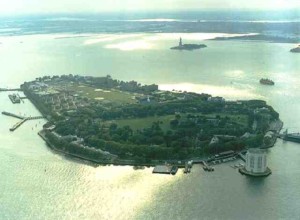 |
| Governor's Island Yesterday |
Governor's Island Today |
|
Early History
One of New York's most
historic landmarks lies approximately a half mile off the tip of Manhattan
in New York Bay. It is Governors Island, site of Fort Jay and from July
1946 to Jun 1966, station for Headquarters, First United States Army.
Governors Island has been an American military post without interruption
since 1794, however, its ties with the history of this country reach even
deeper into the past.
The first white man to see the Island was probably the
explorer Giovanni de Verrazano who reached the harbor in 1524. At that
time the Island was thickly covered with oak, hickory and chestnut trees.
Its Indian name, "Pagganck" and Dutch name, "Nooten Eylandt"
or "Nutten Island" referred to these groves of nut trees.
The story of the Island really begins with its purchase
from the Indians of Manahatas on June 16, 1637. Then Wouter Van Twiller,
the Director General of New Netherlands bought Pagganck from the Indians,
Cakapeteyno and Pebiwas for what is believed to have been two ax heads, a
string of beads and a few nails. Although Van Twiller may not have lived
on Nutten, records show that he did keep 21 pairs of goats there. Not long
after he became Governor,Van Twiller was charged will illegal trading and
incompetence. Knowing that he would be replaced, he decided to take Nutten
for himself. At a meeting of his Council attended by Cakapeteyno and
Pehiwas, he arranged to receive Nutten as a grant. Later in 1638, Van
Twiller was sent home and his purchase of Nutten was declared in violation
of the West India Company's Charter. On July 1, 1652 the Director General
and Council formally annulled the purchase and returned Nutten to public
domain.
From then on, it was set aside as an estate for the Dutch Governors and
later, for their English successors. Van Twiller, thus, 'Was probably the
only private owner of the Island.
In 1664 the English
captured New Amsterdam and renamed it New York. They also took Nutten
which the Dutch had not fortified despite its strategic location. Nine
years later, during the Third Anglo-Dutch War the Dutch regained their
lost province, only to lose it again to England under the terms of the
Treaty of Westminster, 1674.
In 1698 the Island was set aside by the Assembly as
being "part of the Denizen of His Majestie's Fort at New York for the
benefit and accommodation of His Majestie's Governors for the time
being," and hence, it came to be called "The Governor's
Island." The Island's name was changed officially from "Nutten"
to"The Governor's" by an Act of Legislature, March 29, 1784.
Gradually "The" and the apostrophe in "Governor's"
were dropped leaving the title as it is today - Governors |
| |
|
 |
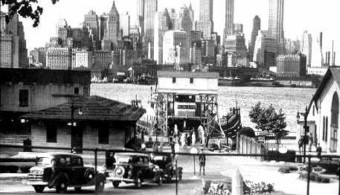 |
| Governors Island - 1951 |
Ferry Entrance
1930's
The only way on and off the Island.
. |
| |
|
 |
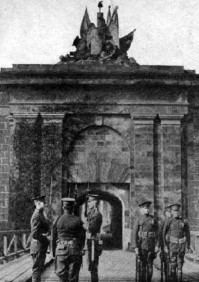 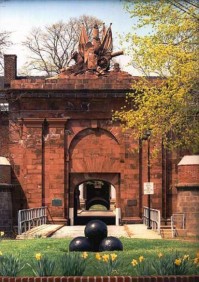 |
|
Castle Williams -
1900's
Was completed in 1811, is named in honor of Colonel Jonathan Williams, who at the
time was the superintendent of West Point and chief engineer of the U.S. Army.
Twenty-seven French 35-pounder cannons lined the lower tier, and thirty-nine 20-pounders
lined the second tier. It was also used as a fort, then as a prison
by the U.S. Army from the Civil War until 1966 |
Ft Jay - 1920
& 1990
Was completed in 1798 and named after Secretary of Foreign Affairs John Jay. The
fort was rebuilt and renamed Fort Columbus in 1803. The change in name is believed
to have been caused by the unpopularity of the treaty with England, which Jay
negotiated in 1795. The original name, Fort Jay, was restored in 1904. The fort
was used as a family housing unit. |
| |
|
|
From 1691 to 1702 the English Colonial Governors urged the fortification of New York
Harbor. In spite of their efforts, only 1500 was raised for defenses at the
Narrows, and in 1702 this was appropriated by Lord Cornbury for the construction
of a mansion on Governors Island. Lord Combury's house was financed also by
a series of unique taxes, including a levy of five shillings and sixpence on everyone
who wore a pearl ring and two shillings and fivepence on every bachelor
over the age of twenty-five. The house was put up on the high ground in the northeast
section of the Island and was used by Lord Cornbury and following governors
as the gubernatorial mansion. It was named, fittingly, "The Smiling Garden
of the Sovereigns of the Province."
Tradition places this house where Building 14 now stands overlooking
San Juan
Dock, in fact, Building 14 may be the actual house. It is known to
have
been built prior to the War of 1812 when it served. as a guard house
and
headquarters of the Island's Garrison. Its cellar then contained the
famous
"Black Hole," a cell for the solitary confinement of difficult
prisoners.
Until the Commanding General's Quarters were erected in 1840,
Building
14 was the senior officer's home and was conunonly called
"the Governor's
House." There is a legend that during the Revolution this
house was
connected by a tunnel to a private dock on Buttermilk Channel,
by which the
Governor could escape to his official barge if the Americans
landed. Although
there is no trace of this rumored tunnel today, it is
supposed to
have been large enough to accommodate the Governor's coach and four horses.
In 1710 The Colonial authorities
designated Governors Island a quarantine station for the large groups of
Palatines who were arriving in America. From 7,000 to 10,000 of these exiles were
camped on the Island at one time. Later they were sent up the Hudson to Green
and Columbia counties. One of these refugees, John Peter Zenger, later became
publisher of the New York Weekly journal and first famous defender of freedom
of the press in America.
Until the middle of the eighteenth century Governors Island remained both unfortified
and unguarded. Although there were many war scares and proposals for defense,
nothing was done either in garrisoning a post or building, works. During this
period, Governors Island seems to have been primarily a sanctuar for birds
and animals. Records show that in addition to Governor Van Twiller's goats,
exactly 103 head of cattle were kept there in 1623. Later, in 1732, Governor
Crosby used the Island as a preserve for English pheasants.
It was officially
designated a preserve for these pheasants in 1738. |
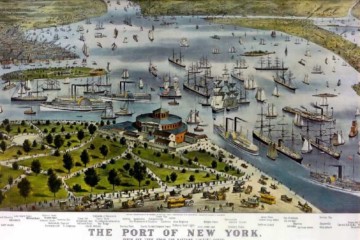 |
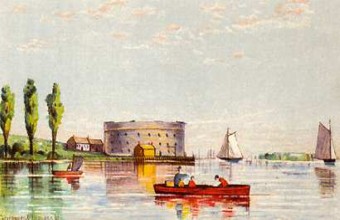 |
| |
Painting of Castle Williams |
Troops were stationed on Governors Island for the first time in 1755. This first
garrison of trained soldiers was the 51st Regiment of British Colonial Militia
under the command of an American born Major General,
Sir William Pepperell.
Pepperell had been Commander-in-Chief of the New England force that captured
the French fortress of Louisbourg. He trained his men to fight in Indian
fashion
rather than according to traditional military principles, and was
chiefly
responsible for training the army that afterward was to achieve
American
independence. The 51st soon was joined by the
22nd Regiment of
Foot, the 44th Regiment of Foot and the
62nd Regiment of Foot, styled the
"Royal Americans."
The
62nd Regiment was a locally recruited unit of the British Regular
Army. It
was organized at Governors Island in 1755 and remained there
for many years.
In 1757 the 62nd Regiment was renamed "The Royal
American Regiment,
H. M. 60th Regiment of Foot."
The first-commander of the Regiment was John
Campbell, the Earl of Loudoun. Lord Jeffrey Amherst was also a commander
and Horatio Gates,later Adjutant General of the Continental Army, was an officer
in this Regiment. There were four battalions in the Regiment and one was known
as the "Governors Island Battalion." Prior to the Revolution the Royal Americans
were ordered to the West Indies, however, the Regiment's band remained behind
and gave concerts for the Loyalists in New York during the war. Following
its tour in the West Indies, the Regiment was ordered to England where it eventually
acquired its present name, "The King's Royal Rifle Corps."
In recognition of shared traditions,the
officers and men of the King's Royal Rifle Corps presented their only ancient
Royal American Regimental color to Governors Island on January 9, 1921. The inscription
accompanying this gift read in part, "to serve as a momento that
the Royal American Regiment and the regiments of New York fought shoulder to
shoulder, not only during the many years of warfare which ended
in the conquest
of New France and the subjection of the Indian tribes bordering on the
Great Lakes, but also, after a century and a half, against a common enemy in a
more terrible European contest." This regimental flag now hangs on the north wall
of the Chapel of Saint Cornelius the Centurion. In appreciation of this gift,
authorities on Governors Island presented a Coehorn mortar to the King's Royal
Rifle Corps on September 12, 1922. The mortar had been on the Island when the
Royal Americans were stationed there. It was overlooked when the British withdrew
and eventually was placed in the Governors Island Officers Club as an historical
trophy. |
|
The above text and photos were taken from http://www.govislandarmybrat.com/
We would like to thank them for their use. For more detail of the
Govenor's Island and the people who lived there please visit their site. |
|
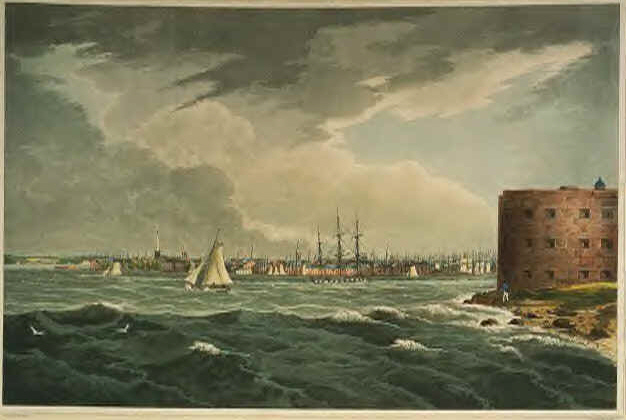
|
| |
|
| |
|
| |
|
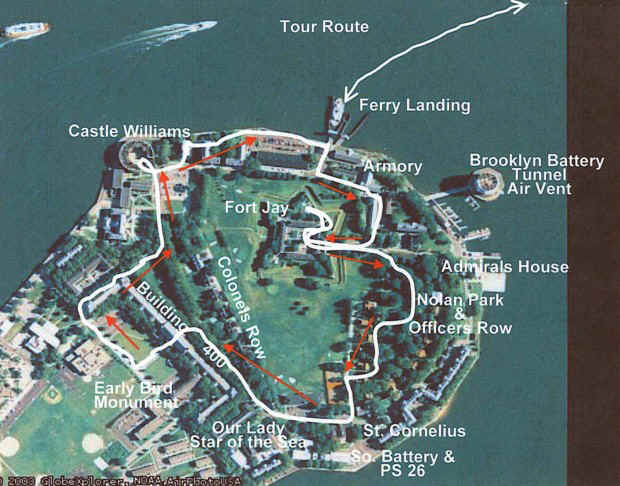
You can now tour Governor's Island. |
| |
|
|
